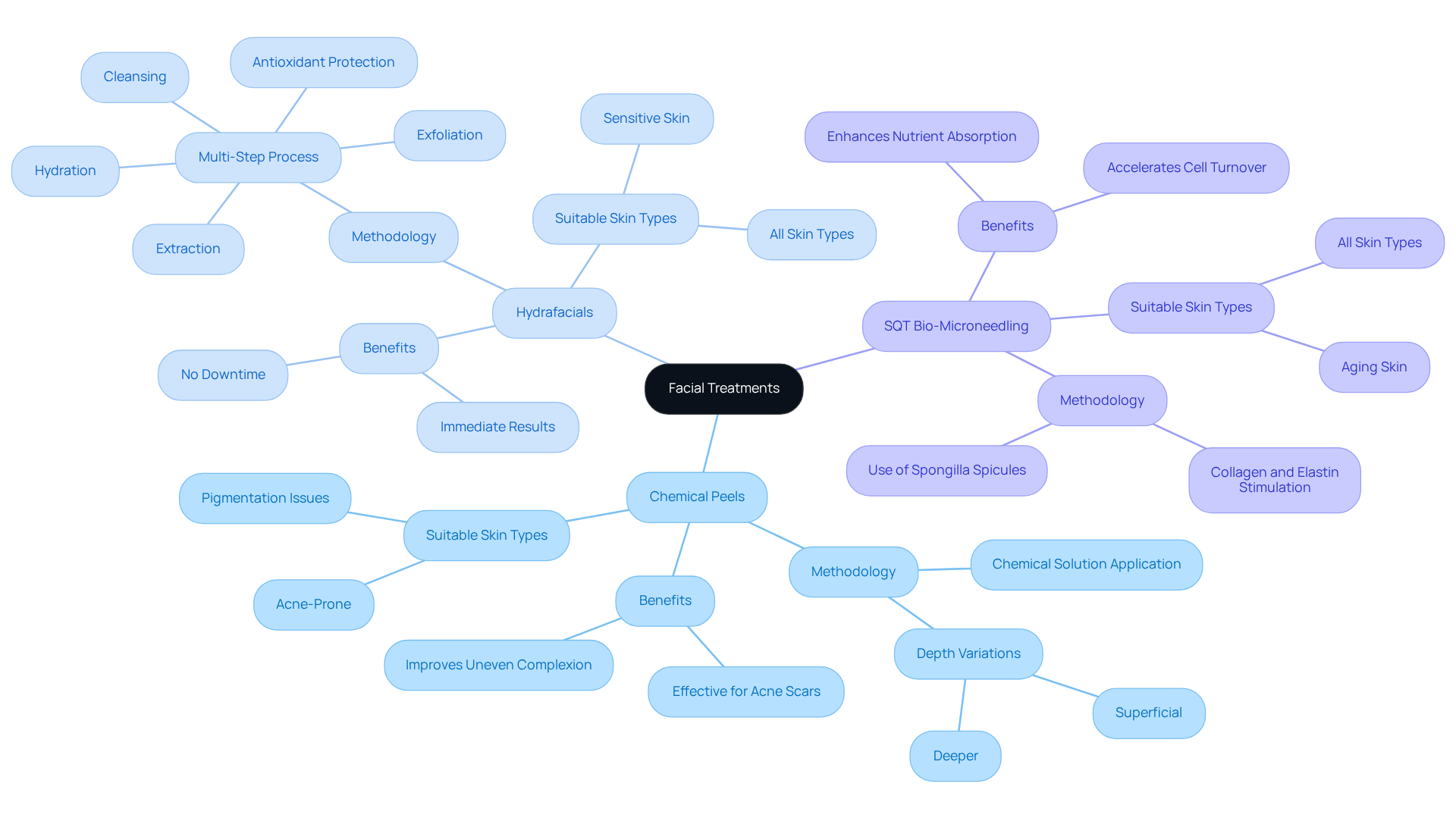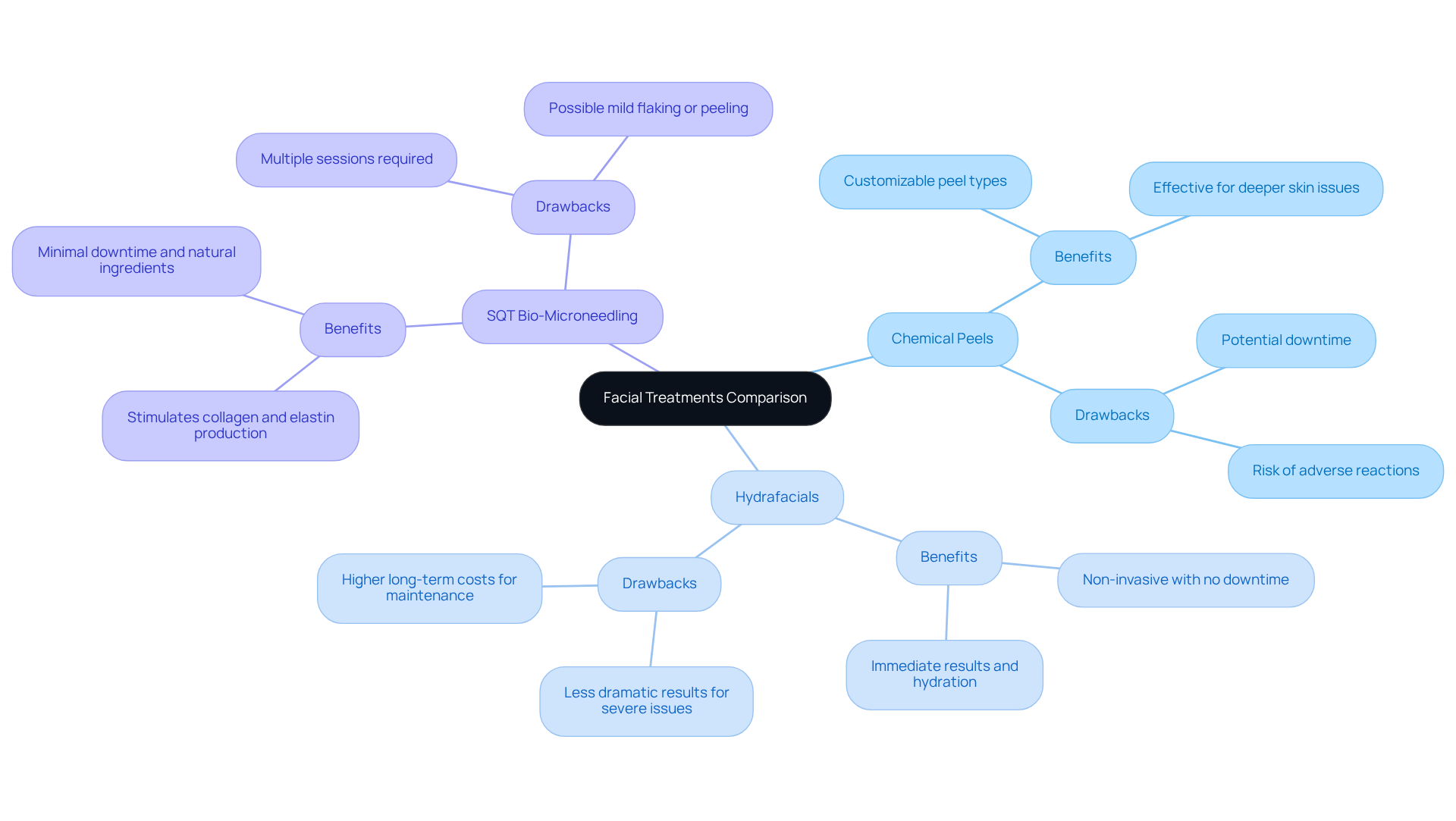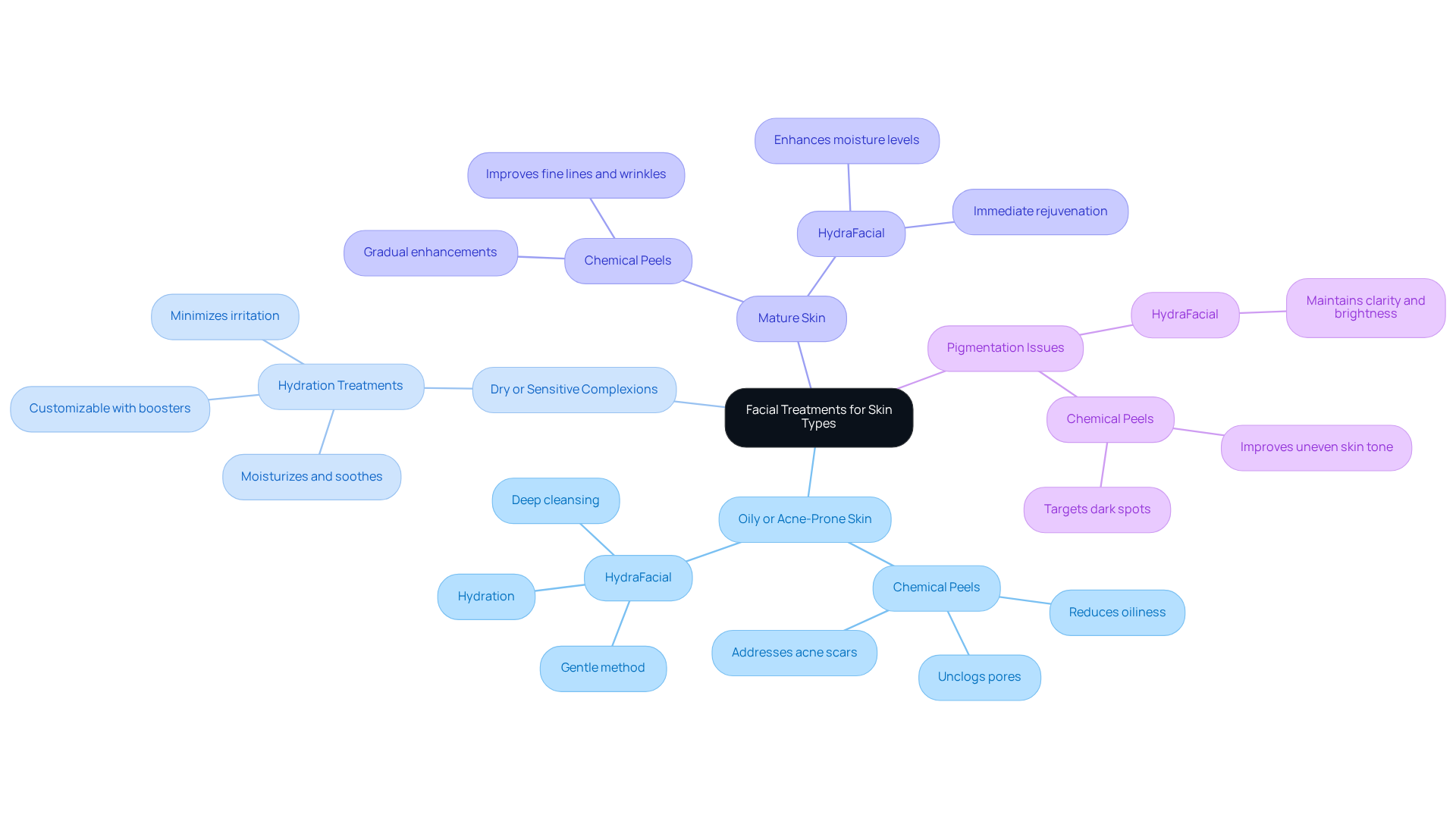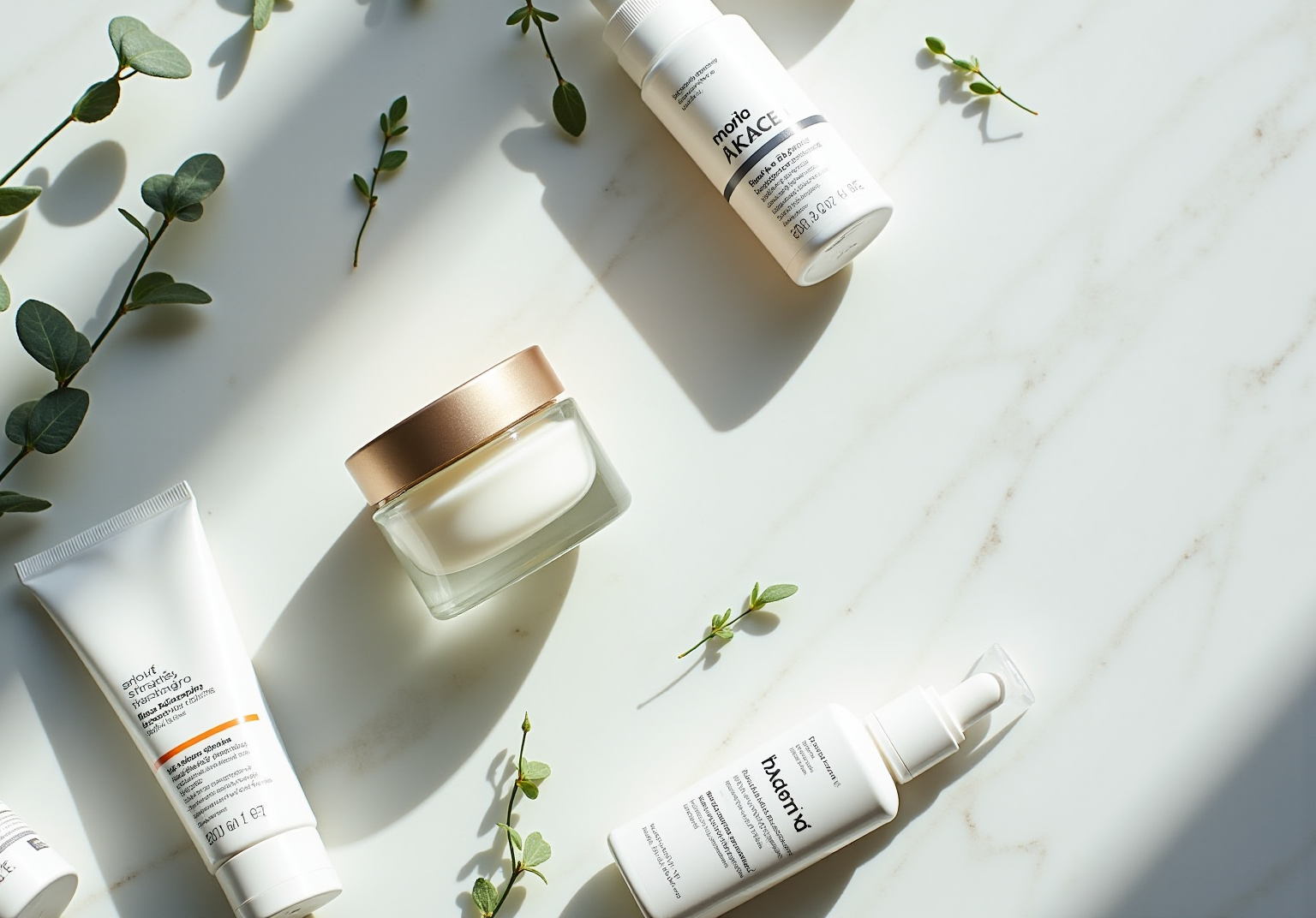Facial Treatments: Compare Chemical Peels and Hydrafacials for You

Overview
This article presents a comprehensive comparison of chemical peels and Hydrafacials, underscoring the distinct advantages of each treatment. Chemical peels are particularly effective for addressing deeper skin issues such as acne scars and pigmentation, making them a preferred choice for individuals seeking significant skin improvement. In contrast, Hydrafacials deliver immediate results without any downtime, making them suitable for all skin types and ideal for those looking for quick, effective solutions.
The discussion elaborates on the benefits and drawbacks of both treatments, providing valuable insights that cater to individual skin concerns and desired outcomes. By weighing the effectiveness of each method, readers can make informed decisions based on their specific needs. Ultimately, this comparative analysis serves as a crucial resource for anyone considering these popular skincare options.
Introduction
Exploring the realm of facial treatments reveals a diverse array of options meticulously crafted to rejuvenate and enhance skin health. Among these, chemical peels and Hydrafacials emerge as two prominent choices, each employing distinct techniques to address various skin concerns. These treatments promise a range of benefits, from deep exfoliation to immediate hydration. Yet, with such varied methodologies, how does one determine which treatment aligns best with their individual skin needs? This article examines the advantages and disadvantages of chemical peels and Hydrafacials, providing insights that empower readers to make informed decisions on their skincare journey.
Understanding Facial Treatments: Chemical Peels and Hydrafacials
Chemical exfoliations and Hydrafacials are two highly regarded facial treatments designed to enhance dermal health, each employing distinct methodologies. Chemical treatments utilize a specialized chemical solution to exfoliate the outer layer of skin, promoting the shedding of dead cells and revealing a rejuvenated layer beneath. The depth of these treatments can vary:
- Superficial options address minor issues,
- Deeper procedures confront more significant concerns such as scarring and pigmentation.
Dermatologists emphasize that chemical peels are particularly effective for treating acne scars and uneven complexions, establishing them as a reliable choice for individuals with specific dermal conditions.
In contrast, Hydrafacials incorporate a comprehensive multi-step process that includes:
- Cleansing
- Exfoliation
- Extraction
- Hydration
- Antioxidant protection
This innovative procedure employs a patented device that injects serums into the dermis while simultaneously extracting impurities, rendering it a gentler option suitable for all skin types. Renowned for delivering immediate results, Hydrafacials offer a radiant glow without any downtime, making them especially appealing for those seeking quick enhancements prior to important events.
Additionally, SQT Bio-Microneedling at Tsavo Wellness introduces an innovative approach to revitalizing the complexion through the use of Spongilla spicules. This groundbreaking therapy stimulates collagen and elastin production, creating millions of micro channels within the dermis to enhance nutrient absorption and accelerate cell turnover. Unlike traditional techniques, SQT Bio-Microneedling is suitable for all skin types and is devoid of adverse effects, making it a safe and effective option for individuals aiming to address various dermal issues, including acne scars, pigmentation, and signs of aging.
The decision between chemical treatments and Hydrafacials relies on a clear understanding of individual dermal objectives and concerns regarding facial treatments. Meanwhile, SQT Bio-Microneedling presents an attractive alternative that combines safety and effectiveness, promoting overall dermal wellness.

Comparative Benefits and Drawbacks of Chemical Peels and Hydrafacials
When comparing chemical peels, Hydrafacials, and the innovative SQT Bio-Microneedling, several benefits and drawbacks of facial treatments emerge that warrant careful consideration.
Chemical Peels:
Benefits:
- Effective for treating deeper skin issues such as acne scars, hyperpigmentation, and fine lines, chemical peels can lead to significant improvements in skin texture and tone over time.
- The variety of peel types available allows for customization based on individual complexion concerns.
Drawbacks:
- There is potential for downtime, particularly with deeper peels, which may involve redness and peeling.
- Additionally, there is a risk of adverse reactions, such as irritation or discoloration, especially for sensitive complexions.
Hydrafacials:
Benefits:
- As a non-invasive treatment with no downtime, Hydrafacials are suitable for all skin types, including sensitive skin.
- Patients can expect immediate results, characterized by a noticeable glow and improved hydration.
- The ability to customize serums to address specific concerns enhances overall effectiveness.
Drawbacks:
- However, results may be less dramatic for severe skin issues compared to chemical peels.
- Furthermore, maintaining results may require regular treatments, which can lead to higher long-term costs.
SQT Bio-Microneedling:
Benefits:
- This innovative technique utilizes Spongilla spicules to stimulate collagen and elastin production, enhancing skin rejuvenation.
- It creates approximately 3-5 million micro channels within a mere 5 minutes, significantly improving the absorption of topical products.
- With minimal downtime and the use of natural ingredients, SQT Bio-Microneedling is suitable for all complexions without the risk of adverse reactions.
- Additionally, its ethical sourcing from freshwater sponges underscores a commitment to sustainability and ecological responsibility.
Drawbacks:
- Like chemical peels and Hydrafacials, multiple sessions are required for optimal results.
- Some clients may experience mild flaking or peeling as the outer layer regenerates, though this varies by individual.
In summary, while chemical treatments may provide more substantial enhancements for specific skin concerns, facial treatments like Hydrafacials offer a milder and more immediate solution with no recovery time necessary. SQT Bio-Microneedling stands out as a groundbreaking alternative, merging effective results with safety and minimal downtime, making it an outstanding selection for those seeking comprehensive care solutions.

Determining Suitability: Which Treatment is Best for Your Skin Type?
Selecting the right facial treatments is crucial for achieving optimal skin health, and it begins with a clear understanding of your skin type and specific concerns.
For Oily or Acne-Prone Skin:
Chemical peels are highly effective, penetrating deeper layers of the skin to address both acne scars and active breakouts. They significantly reduce oiliness and unclog pores, with recovery times varying based on the depth of the peel. Additionally, facial treatments provide deep cleansing and hydration, making them ideal for individuals seeking a gentler method without irritation. The HydraFacial procedure, consisting of three primary steps—Cleanse and Peel, Extract and Hydrate, and Fuse and Protect—provides a comprehensive approach to facial treatments.
For Dry or Sensitive Complexions:
Hydration treatments are often the preferred choice, as they moisturize and soothe the surface while minimizing the risk of irritation associated with chemical peels. This procedure features gentle exfoliation and intense hydration, improving texture without causing redness or discomfort. Dr. Burns emphasizes that facial treatments, specifically Hydration Treatments, can be customized with boosters to target specific issues, making them particularly suitable for delicate complexions.
For Mature Skin:
Both procedures yield beneficial outcomes, yet chemical exfoliations may provide more pronounced improvements for fine lines and wrinkles. Hydrafacials can complement chemical treatments and are considered effective facial treatments by enhancing moisture levels and improving the overall appearance of the complexion, thereby enriching an anti-aging regimen. The immediate results of a Hydrafacial can deliver a rejuvenated look, while chemical treatments showcase gradual enhancements as the skin recovers.
For Pigmentation Issues:
Chemical peels are frequently recommended for more severe pigmentation concerns, effectively targeting dark spots and uneven skin tone. Conversely, Hydrafacials help maintain clarity and brightness, serving as a supportive treatment to keep the complexion vibrant.
Ultimately, consulting with a skincare expert is essential to determine the most suitable facial treatments based on individual assessments and desired outcomes. This personalized approach guarantees that the selected treatment aligns with specific skin needs and goals.

Conclusion
Selecting the appropriate facial treatment is crucial for achieving optimal skin health and appearance. Chemical peels and Hydrafacials each provide distinct advantages tailored to various skin concerns. Chemical peels are particularly effective in addressing severe issues such as acne scars and pigmentation, while Hydrafacials offer a gentler, immediate glow that is suitable for all skin types. Moreover, innovative treatments like SQT Bio-Microneedling present a compelling alternative, merging safety with effective results.
This article has examined the comparative advantages and limitations of each treatment. Chemical peels are acknowledged for their depth and efficacy in tackling significant skin issues; however, they may entail downtime and a risk of irritation. In contrast, Hydrafacials are praised for their non-invasive nature and instant results, though they often necessitate regular sessions for maintenance. SQT Bio-Microneedling stands out as a safe and effective option that enhances nutrient absorption while minimizing downtime.
Ultimately, understanding individual skin types and concerns is vital in selecting the most appropriate treatment. Engaging with a skincare professional can yield personalized recommendations, ensuring that the chosen facial treatment aligns with specific needs. By embracing the right facial treatment, one not only enhances skin health but also boosts confidence, underscoring the significance of making informed choices in skincare routines.
Frequently Asked Questions
What are chemical peels and how do they work?
Chemical peels are facial treatments that use specialized chemical solutions to exfoliate the outer layer of skin. They promote the shedding of dead cells, revealing a rejuvenated layer beneath. The depth of the treatment can vary, with superficial options addressing minor issues and deeper procedures targeting more significant concerns like scarring and pigmentation.
What skin issues are chemical peels effective for?
Chemical peels are particularly effective for treating acne scars and uneven complexions, making them a reliable choice for individuals with specific dermal conditions.
What is a Hydrafacial and what does it involve?
A Hydrafacial is a multi-step facial treatment that includes cleansing, exfoliation, extraction, hydration, and antioxidant protection. It uses a patented device to inject serums into the dermis while extracting impurities, providing a gentler option suitable for all skin types.
What are the benefits of Hydrafacials?
Hydrafacials are renowned for delivering immediate results, providing a radiant glow without any downtime. This makes them especially appealing for individuals seeking quick enhancements before important events.
What is SQT Bio-Microneedling and how does it differ from traditional microneedling?
SQT Bio-Microneedling is an innovative treatment that uses Spongilla spicules to stimulate collagen and elastin production. It creates millions of micro channels within the dermis to enhance nutrient absorption and accelerate cell turnover. Unlike traditional techniques, it is suitable for all skin types and has no adverse effects.
What skin issues can SQT Bio-Microneedling address?
SQT Bio-Microneedling can address various dermal issues, including acne scars, pigmentation, and signs of aging.
How should one decide between chemical peels, Hydrafacials, and SQT Bio-Microneedling?
The decision between these treatments should be based on a clear understanding of individual dermal objectives and concerns regarding facial treatments. Each option offers distinct benefits tailored to specific skin needs.


